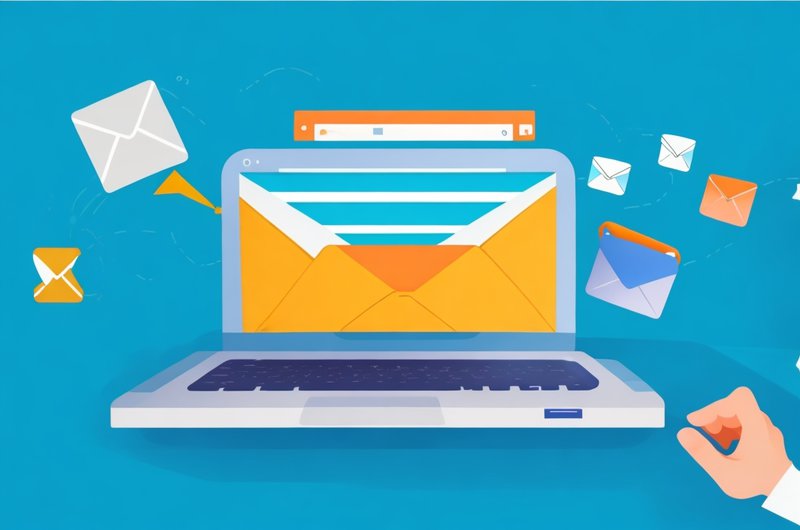What Is Email Marketing and How Does It Work

In the vast digital landscape, where information flows like a river, email marketing stands as a steadfast beacon, guiding businesses towards success. Like a skilled orchestrator, it harmonizes creative, persuasive, and analytical elements to engage and captivate audiences.
With each email sent, a connection is forged, building a loyal following and nurturing fruitful relationships.
Through the power of automation and meticulous measurement, email marketing unlocks the door to freedom, allowing businesses to thrive and flourish in a realm of endless possibilities.
Key Takeaways
- Email marketing is a strategic tool that allows businesses to reach a wide audience and drive engagement with quantifiable outcomes.
- It is a cost-effective and efficient way to deliver personalized messages based on customer preferences and behaviors, which increases customer engagement and builds trust.
- Email marketing is a cost-effective promotional tool that reaches a large audience at a fraction of the cost of traditional advertising, and it allows businesses to create relevant and resonating messages.
- Automating email marketing and measuring success through key metrics such as open rates, click-through rates, and conversion rates allows businesses to save time, personalize content, and continuously improve and optimize their campaigns.
The Definition of Email Marketing
The precise definition of email marketing encompasses the strategic use of electronic communications to reach a vast audience and drive engagement with quantifiable outcomes. In today’s fast-paced digital world, email marketing has become an essential tool for businesses to connect with their target audience and build strong relationships.
It provides a cost-effective and efficient way to deliver personalized messages directly to individuals’ inboxes, allowing businesses to nurture leads, promote products or services, and increase brand awareness. Email marketing offers the freedom to tailor messages based on customer preferences and behaviors, ensuring that the content is relevant and engaging.
The Benefits of Email Marketing
Email marketing offers a multitude of benefits for businesses looking to connect with their customers.
Firstly, it allows for increased customer engagement by providing a direct and personalized line of communication.
Secondly, it is a cost-effective promotional tool, as it eliminates the need for physical mailings and allows for easy tracking of campaign success.
Lastly, email marketing enables businesses to create personalized and targeted campaigns, ensuring that messages are relevant and resonate with recipients.
Increased Customer Engagement
Importantly, increased customer engagement can lead to higher conversion rates and improved brand loyalty. Engaging with customers is crucial for businesses to thrive in today’s competitive market. Here are four key reasons why customer engagement is essential:
- Building trust: When customers feel engaged, they develop a sense of trust in the brand, making them more likely to make repeat purchases and recommend the business to others.
- Personalization: Engaging with customers allows businesses to understand their preferences and needs, enabling personalized marketing campaigns that resonate with individual customers.
- Feedback and improvement: Customer engagement provides businesses with valuable feedback that can be used to improve products, services, and overall customer experience.
- Advocacy and word-of-mouth marketing: Engaged customers are more likely to become brand advocates, sharing positive experiences with their networks, which can lead to increased brand awareness and customer acquisition.
Cost-Effective Promotional Tool
In today’s digital landscape, businesses are increasingly leveraging email marketing as a highly efficient and cost-effective promotional tool. With its ability to reach a large audience at a fraction of the cost of traditional advertising methods, email marketing has become a preferred choice for businesses of all sizes.
Email marketing allows businesses to send targeted messages directly to their customers’ inboxes, increasing the likelihood of engagement and conversions. By segmenting their email lists based on demographics, interests, and past purchase behavior, businesses can tailor their messages to specific customer groups, maximizing the effectiveness of their campaigns.
Using email marketing software, businesses can track open rates, click-through rates, and conversions, providing valuable insights into the success of their campaigns. This data can be used to further optimize and improve future email marketing efforts.
Overall, email marketing offers businesses a highly efficient and cost-effective way to promote their products and services, making it an essential tool in today’s competitive market.
| Pros | Cons |
|---|---|
| Cost-effective | Risk of being flagged as spam |
| Targeted messaging | Potential for unsubscribes |
| Measurable results | Requires regular content creation |
Personalized and Targeted Campaigns
With the ability to tailor messages based on customer demographics and interests, personalized and targeted campaigns are a valuable aspect of email marketing. These campaigns allow businesses to connect with their audience on a deeper level, increasing engagement and driving conversions.
Here are four reasons why personalized and targeted campaigns are essential for successful email marketing:
- Increased Relevance: By delivering messages that are specifically tailored to each individual’s interests and needs, businesses can ensure that their emails are more relevant and engaging.
- Improved Open and Click-through Rates: Personalized campaigns have been shown to have higher open and click-through rates compared to generic email blasts.
- Enhanced Customer Experience: By sending targeted content, businesses can provide a more personalized and enjoyable experience for their customers, leading to increased loyalty and satisfaction.
- Higher ROI: Personalized campaigns have the potential to generate higher return on investment (ROI) by driving more conversions and repeat business.
Building an Email List
Building an email list is a crucial step in email marketing, as it forms the foundation for successful campaigns. One important aspect to consider is the difference between opt-in and purchased email lists.
Opt-in lists consist of subscribers who have willingly provided their email addresses, ensuring a higher level of engagement and interest.
Another key strategy is segmenting your audience, allowing you to tailor your messages and offers to specific groups based on their demographics, preferences, or behavior.
Lastly, growing your subscriber base should be an ongoing effort, utilizing various tactics such as website sign-up forms, social media promotions, and lead magnet offers to attract new subscribers and expand your reach.
Opt-In Vs. Purchased
One must carefully consider the advantages and disadvantages of purchasing an email list versus opting in to ensure the effectiveness and legality of their email marketing strategy.
- Purchasing an email list:
- Provides a quick way to reach a large number of potential customers.
- Saves time and effort in building a list from scratch.
- May include contacts with a higher chance of conversion based on specific targeting options.
- Raises concerns about the quality and relevance of the purchased contacts, potentially leading to lower engagement and higher unsubscribe rates.
- Opting in:
- Ensures that recipients have willingly expressed interest in receiving emails, resulting in a higher chance of engagement.
- Builds a more targeted and engaged audience over time.
- Helps maintain a positive brand image by respecting recipients’ preferences.
- Requires ongoing effort and investment to attract and retain subscribers.
Ultimately, the decision between purchasing an email list and opting in depends on factors such as budget, time constraints, and the importance of building a genuine and engaged audience for long-term success.
Segmenting Your Audience
To effectively target your audience, you can segment your email list based on demographics and preferences, ensuring that your marketing messages resonate with the right recipients and yield higher engagement rates. By dividing your email list into specific segments, you can tailor your content to meet the unique needs and interests of each group. This not only increases the relevance of your emails but also enhances the overall effectiveness of your email marketing campaigns.
Segmenting your audience allows you to personalize your messages, making them more compelling and engaging. It enables you to deliver the right content to the right people at the right time, resulting in higher open rates, click-through rates, and conversions. Here is an example of how you can segment your email list:
| Segment | Demographics | Preferences |
|---|---|---|
| Segment A | Age: 18-25 | Interest: Fashion |
| Segment B | Age: 35-45 | Interest: Technology |
| Segment C | Age: 55+ | Interest: Travel |
Growing Your Subscriber Base
An effective strategy for growing your subscriber base is to optimize your website’s landing pages to encourage visitors to sign up for your email list. By implementing the following tactics, you can maximize your chances of converting website visitors into loyal subscribers:
- Create a compelling call-to-action (CTA) that clearly communicates the value of joining your email list.
- Offer an incentive, such as a free downloadable resource or exclusive content, to entice visitors to provide their email addresses.
- Use social proof, such as testimonials or user reviews, to build trust and credibility with your audience.
- Optimize your landing page design and layout for a seamless user experience, making it easy for visitors to find and complete the sign-up form.
By implementing these strategies, you can effectively grow your subscriber base and establish a strong email marketing foundation for your business.
Don’t miss out on the opportunity to engage with your audience and nurture valuable relationships through email marketing. Start optimizing your landing pages today!
Crafting Effective Email Campaigns
The article provides valuable insights on crafting effective email campaigns. Email marketing has become a crucial tool for businesses to connect with their audience and drive conversions. To create successful campaigns, it is important to understand the needs and preferences of your subscribers.
A creative and persuasive approach is essential to capture their attention and encourage them to take action. Analyzing the data and metrics from previous campaigns can provide valuable insights into what works and what doesn’t.
Designing visually appealing and mobile-friendly email templates, personalizing the content, and using compelling subject lines are some of the strategies that can yield positive results. By crafting effective email campaigns, businesses can build strong relationships with their subscribers and achieve their marketing goals.
Automating Email Marketing
Automating email marketing allows businesses to streamline their communication efforts and efficiently deliver personalized content to their subscribers. With the advancement of technology, email automation has become an indispensable tool in the marketing arsenal.
Here are some key benefits of automating email marketing:
- Time-saving: Automation eliminates the need for manual tasks, saving valuable time for businesses to focus on other important aspects.
- Personalization: By leveraging automation tools, businesses can deliver tailored content based on customer preferences and behaviors, increasing engagement and conversion rates.
- Segmentation: Automation allows businesses to segment their audience based on various demographics, interests, or purchasing behavior, ensuring relevant messages are delivered to the right people.
- Triggered campaigns: Automation enables businesses to set up triggered campaigns based on specific actions or events, such as abandoned carts or birthdays, ensuring timely and relevant communication.
Measuring Email Marketing Success
To accurately measure email marketing success, businesses need to track key metrics such as open rates, click-through rates, and conversion rates to gain insights into the effectiveness of their campaigns.
Open rates indicate how many recipients actually opened the email, while click-through rates measure the number of recipients who clicked on links within the email.
Conversion rates, on the other hand, show how many recipients took the desired action, such as making a purchase or signing up for a newsletter.
By tracking these metrics, businesses can assess the impact of their email marketing efforts and make informed decisions to optimize their campaigns.
This data-driven approach allows for continuous improvement and ensures that businesses are maximizing the potential of email marketing to reach their desired audience and drive meaningful results.
Frequently Asked Questions
What Are Some Common Mistakes to Avoid When Building an Email List?
When building an email list, it is crucial to avoid common mistakes. These can include purchasing email lists, not obtaining proper consent, failing to segment the list, sending irrelevant content, and neglecting to provide an easy unsubscribe option.
How Can I Ensure My Email Campaigns Are Engaging and Personalized?
To ensure engaging and personalized email campaigns, focus on creating relevant content, segmenting your audience, and using personalization techniques like dynamic content and personalized subject lines. Regularly analyze your campaign data to optimize and improve performance.
What Are Some Best Practices for Creating Effective Subject Lines in Email Marketing?
To create effective subject lines in email marketing, it is important to be concise, engaging, and personalized. Avoid generic phrases and focus on enticing the reader with a clear value proposition or intriguing statement. Test subject lines to determine what resonates best with your audience.
How Can I Segment My Email List to Target Different Customer Groups?
Segmenting your email list allows you to target different customer groups effectively. By dividing your subscribers based on demographics, interests, or purchasing behavior, you can tailor your email content and offers to their specific needs, increasing engagement and driving conversions.
What Metrics Should I Track to Measure the Success of My Email Marketing Campaigns?
To measure the success of email marketing campaigns, it is essential to track metrics such as open rates, click-through rates, conversion rates, bounce rates, and unsubscribe rates. These metrics provide valuable insights into the effectiveness of your campaigns and guide future strategies.








